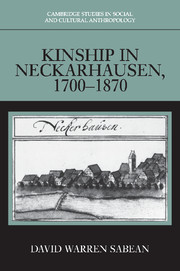Book contents
- Frontmatter
- Contents
- List of tables
- Abbreviations
- Abbreviations of sources
- On reading kinship diagrams
- Glossary
- Preface
- Introduction
- 1 An introduction to kinship
- 2 Vetterleswirtschaft: Rise and fall of a political discourse
- 3 The politics of incest and the ecology of alliance formation
- Cohort I (1700–1709)
- Cohort II (1740–1749)
- Cohort III (1780–1789)
- Cohort IV (1820–1829)
- Cohort V (1860–1869)
- Conclusion
- Appendix
- Bibliography
- General index
- Index of villagers
1 - An introduction to kinship
Published online by Cambridge University Press: 04 August 2010
- Frontmatter
- Contents
- List of tables
- Abbreviations
- Abbreviations of sources
- On reading kinship diagrams
- Glossary
- Preface
- Introduction
- 1 An introduction to kinship
- 2 Vetterleswirtschaft: Rise and fall of a political discourse
- 3 The politics of incest and the ecology of alliance formation
- Cohort I (1700–1709)
- Cohort II (1740–1749)
- Cohort III (1780–1789)
- Cohort IV (1820–1829)
- Cohort V (1860–1869)
- Conclusion
- Appendix
- Bibliography
- General index
- Index of villagers
Summary
We need only as much theory as necessary.
– Jack Goody, Expansive MomentDuring the three decades it took to put this study together, visions of Casaubon danced in my head, while all about me scholarly interest in population studies and in kinship analysis was on a steep decline. With the recent loss of faith in social analysis, the basic weapons of the social historian's armament, such as “class,” have been blunted or tossed aside. Yet I still find “class” a useful instrument, and in one way or another this book beats its way toward an argument that explains how kinship and class have interacted with each other during the modern era. The fact that these two concepts have been replaced in many disciplines by “identity” and “selfhood” has left me with the quixotic task of breaking a social-historical lance on the windmills of subjectivity.
In 1968 I set out to look at a relatively simple question arising from the widely held view among social scientists that modernization had fundamentally altered the nature of the family in Western civilization and that each social epoch was characterized by a dominant form of familial relations. People in Europe, so the story went, had once constructed their lives within a dense network of kin.
- Type
- Chapter
- Information
- Kinship in Neckarhausen, 1700–1870 , pp. 2 - 36Publisher: Cambridge University PressPrint publication year: 1997
- 1
- Cited by



